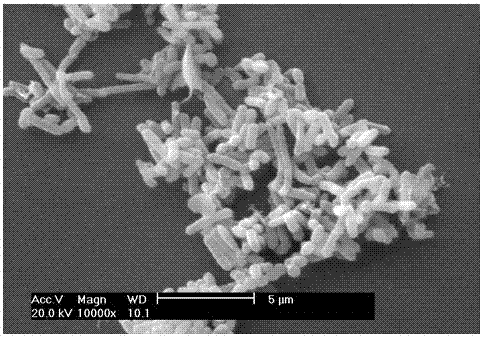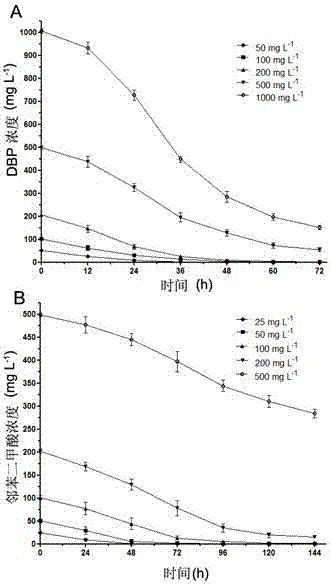A strain of Providencia sp. 2D that efficiently degrades dibutyl phthalate
A technology of Providence bacteria and strains, which is applied in the field of biological treatment of environmental pollutants, can solve problems such as incomplete biodegradation, and achieve the effects of simple culture method, less variation and strong adaptability.
- Summary
- Abstract
- Description
- Claims
- Application Information
AI Technical Summary
Problems solved by technology
Method used
Image
Examples
Embodiment 1
[0019] Example 1 Isolation and identification of dibutyl phthalate degrading bacteria
[0020] 1. Medium formula
[0021] Inorganic salt culture medium (MSM, g / L): K 2 HPO 4 : 5.8; KH 2 PO 4 : 4.5; (NH 4 ) 2 SO 4 : 2.0; MgCl 2 :0.16; CaCl 2 :0.02; Na 2 MoO 4 ·2H 2 O: 0.0024; FeCl 3 : 0.0018; MnCl 2 ·2H 2 O: 0.0015; adjust the final pH of the inorganic salt culture solution to 7.5, add DBP to make the concentration in the inorganic salt culture solution 50 mg / L, and DBP as the sole carbon source.
[0022] Beef extract peptone medium (LB): 5.0 g yeast powder, 10.0 g peptone, 10.0 g sodium chloride, add ultrapure water to 1L, adjust pH=7.0. Sterilize at 121°C for 20 minutes. For solid plates, add 1.5% (W / V) agar powder.
[0023] 2. Separation and identification
[0024] The separation method adopts the sample suspension shake flask method: weigh 5 g of compost sample (taken from farm animal compost) in a 150 mL Erlenmeyer flask containing 50 mL of sterile water, culture at 30°C and 140 rp...
Embodiment 2
[0029] Example 2 Providencia sp. 2D degradation experiment of DBP and its intermediate product phthalic acid
[0030] 1. Preparation of bacterial suspension
[0031] The purified strain Providencia sp. 2D was connected to 10 mL of LB liquid medium for overnight activation and culture to the logarithmic phase. The bacteria were collected by centrifugation at 5000 rpm for 10 min, washed with PBS for 3 times and resuspended, and adjusted the OD 600 nm = 0.8 as a bacterial suspension.
[0032] 2. Determination of degradability
[0033] Inoculate 1 mL of MSM culture medium containing different concentrations of DBP (50, 100, 200, 500, 1000 mg / L) and phthalic acid (25, 50, 100, 200, 500 mg / L) respectively into 100 mL, With no inoculation as a control, and adjust the pH to 8.0, three replicates in each group. Incubate at 30°C, 140 rpm constant temperature shaker for 6 days, take samples regularly, and determine the degradation of DBP and phthalic acid by GC / MS.
[0034] Chromatographic co...
PUM
 Login to View More
Login to View More Abstract
Description
Claims
Application Information
 Login to View More
Login to View More - R&D
- Intellectual Property
- Life Sciences
- Materials
- Tech Scout
- Unparalleled Data Quality
- Higher Quality Content
- 60% Fewer Hallucinations
Browse by: Latest US Patents, China's latest patents, Technical Efficacy Thesaurus, Application Domain, Technology Topic, Popular Technical Reports.
© 2025 PatSnap. All rights reserved.Legal|Privacy policy|Modern Slavery Act Transparency Statement|Sitemap|About US| Contact US: help@patsnap.com



